|
The courts of justice

The Town Hall at Bourne was also used as
a courtroom or Sessions House from the time it was built in 1821, for the petty
sessions or police courts, usually held weekly, and for the quarter
sessions, convened every three months for the hearing of more serious
cases and the imposition of heavier
sentencing. These hearings continued for almost
two centuries but were finally phased out in 2008 when the courtroom was
closed and arrangements made for cases to be heard elsewhere in the
county.
The courtroom was originally used for
criminal cases but a
court convened under the County Courts Act to hear civil cases, notably
the recovery of debts under £20, was established in 1847, the jurisdiction
covering an area of South Lincolnshire with a population of 23,000, thus
increasing the importance of Bourne within the county. This was known as
the Bourne Small Debts Court and Mr J D Burnaby was appointed judge with
Maurice P Moore, of Sleaford, clerk of the court.
The busiest time for the courts was in the
19th century when crimes and misdemeanours kept the magistrates busy with
hearings at least once a week for the police courts or petty sessions and
the quarter sessions being held for the more serious crimes and heavier
sentencing once every three months. Justice during this period was swift
and punishment severe with imprisonment and even deportation for what
would be regarded today as minor offences. In 1811, for instance, the
magistrates sent an unmarried girl, Elizabeth Whitfield, of Stainfield,
to the House of Correction at Folkingham for one year for
having an illegitimate child, her third within five years, and leaving
them to be looked after by the parish.
A sixteen-year-old servant girl, Priscilla Woodward, came before the court
in 1832 accused of setting fire to a haystack belonging to her master,
farmer Isaac Teesdale, of Haconby, and although the
magistrates were told that she was backward and ignorant and unable to
read or write, she was sentenced to be deported to Australia. Other
transportations included Augustine Chamberlain, aged 23, a labourer, who was
accused in 1825 of stealing 24 chickens and ducks, the property of John
Wilson, of Grimsthorpe, who was sent to Bermuda for seven years, and Sarah Marvin, aged 15, also a
servant girl, who was found guilty in 1836 of stealing five bed sheets
from Elizabeth Seward, of Dyke, and was transported to
Tasmania for seven years.
In 1854, William Henry Marshall was accused of breaking into the dwelling
house of William Elfleet, a farmer, of Eastgate, and stealing
bacon, ham, liquor and two sovereigns and sent to jail for four months and
in 1879, Frederick Rouse was sentenced to three months after being found
guilty of stealing gin, wine and food from the North Street grocery shop
where he worked.
Cases of drunkenness were a regular occurrence and in 1888, the chairman
of the bench, the Rev George Carter, Rector of Folkingham, told a sitting
of the magistrates on Thursday 27th September that 11 out of the 16 police
cases that had been heard that day were directly due to drink and that if
it were not for that, the justices of Bourne would have very little or
nothing to do. However, figures produced to the court revealed that during
the previous three years, convictions for drunkenness were declining, from
223 in 1885 to 159 in 1886 and 127 in 1887 and so it was believed that the
punishments being meted out were having an effect.
Those who have sat as magistrates for Bourne include many prominent people
from our past history who were also actively involved in other spheres of
civic, religious and charitable work. Among those who served with
distinction on the bench and also became chairmen were William Wherry
(1841-1915), whose family firm survives to this day, Thomas Mays
(1856-1934), father of Raymond Mays, the motor racing pioneer, and Robert
Gardner (1850-1926), bank manager and talented artist whose paintings were
exhibited by the Royal Academy.
The appearance of the courtroom remained
virtually unchanged from 1821 until the layout of the upper floors of
the Town Hall was altered during refurbishment in 1974-75, thus reducing
its size, but it continued as the seat of justice in Bourne and the
magistrates' court was held there weekly for summary jurisdiction with a
public gallery for anyone who wished to watch the proceedings. The
courtroom was also used for regular meetings of the town council and there
was an adjoining library or committee room where the magistrates adjourned
to consider their decisions when necessary.
An assessment of the use of the Town Hall as a courtroom was issued in
January 2003 by Lincolnshire Magistrates Courts Committee:
-
In 2001, the court sat for 330 hours compared
to an average of 334 hours between 1993 and 1997.
-
Fifty people attended court in September 1997,
79 in June 1998 and between January and March 2002, a total of 224 people
attended.
-
There were 23 Justices of the Peace on the
Bourne and Stamford benches and four of the five categories of work -
adult crime, youth crime, fine enforcement and family - were handled at
Bourne.
-
Annual running costs were £1,595. The average
cost per sitting in the county was £35.48, at Bourne it was £6.17.
While Lincolnshire County Council now owns
Bourne Town Hall, it is South Kesteven District Council which leases it
and in turn allowed the Magistrates Courts Committee to make use of the
facilities on payment of a peppercorn rent. This arrangement came to an end
with the final sitting of the magistrates which was held on
Monday 1st April 2008 when tributes were paid by the various officers who
had been using the courtroom.
Mr Greg Cejer, the presiding magistrate, who had been sitting as a justice
for 15 years, expressed regret at the closure. "It is sad for all of us
working in the judicial system but times change", he said. "The facilities
are not the best, we have not got disabled access, for instance, and we
have not got the levels of segregation required."
Shelley Wilson, from the Crown prosecution Service, said that she had
found working in such an historic interior an enjoyable experience while
duty solicitor, Andrew Cogan (of CWW Solicitors) acknowledged that
although progress must be made, the closure was a great shame for our tradition.
The phasing out of Bourne was part of a major reorganisation of the justice system in
Lincolnshire which also brought about the closure of courts at Sleaford,
Louth and Gainsborough. The courthouse in the town hall at Stamford
had already shut in 2005 when cases were moved to Bourne.
A spokesman for Her Majesty's Court Services, Mark Kram, said that cases
normally held at Bourne would in future be held at Spalding and Grantham.
He added: "Unfortunately, this means that a small number of people will be
travelling a little further for hearings. But the courthouses where their
cases will be dealt with have better and more appropriate facilities.
Witnesses will be able to claim for travelling as normal."
|
A LAST LOOK AT THE COURTROOM
Photographed Tuesday 15th April 2008 |
|
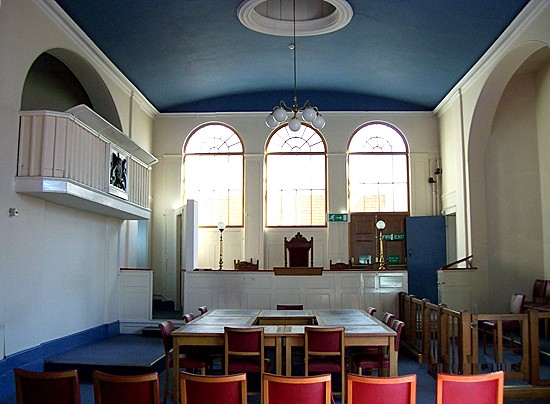 |
|
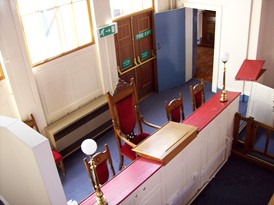 |
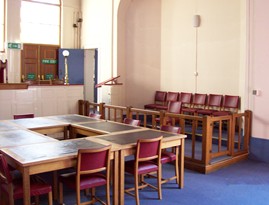 |
|
 |
|
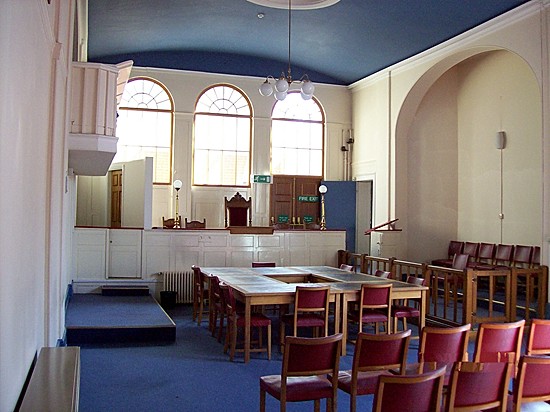 |
|
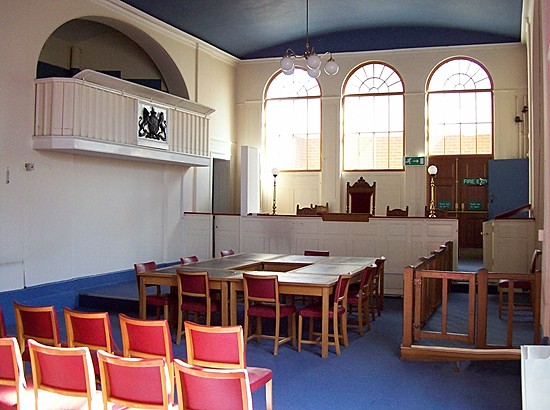 |
|
FROM THE ARCHIVES |
|
A curious incident occurred at the Sessions
House in Bourne on Monday last. Just as a trial for robbery was
about to commence, and which it was expected would last three or
four hours, the chairman asked the jury (who had been in court from
ten till four o'clock) whether they would not like to retire for a
few minutes. The famished jurors did not seem to require a second
asking, for some of them rose and left the box immediately. The
Clerk of the Peace, seeing the movement, and remembering that they
had been sworn for the case about to be tried, called a bailiff and
charged him upon his oath to keep them "without meat, drink or
firing". Those who had not got out of the box drew long faces at
this injunction and the bailiff guarded them out of court: the
others were too quick for the officer - they had got clear of the
courthouse; and before they could be got together again a lucky few
had refreshed themselves with the forbidden food, much to the envy
of those whom the officer had kept under his clutches.
- news item from the Stamford Mercury, Friday 10th April 1846. |
REVISED AUGUST 2016
Return to The
Town Hall

Go to:
Main Index Villages
Index
|






